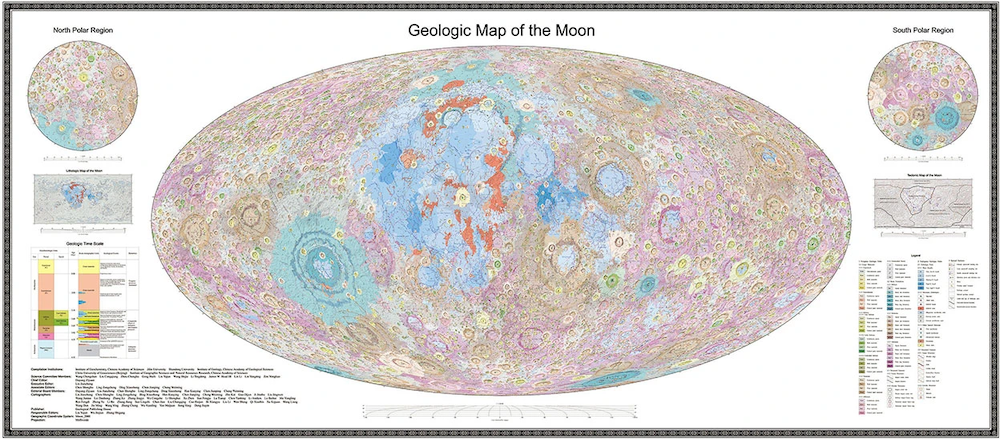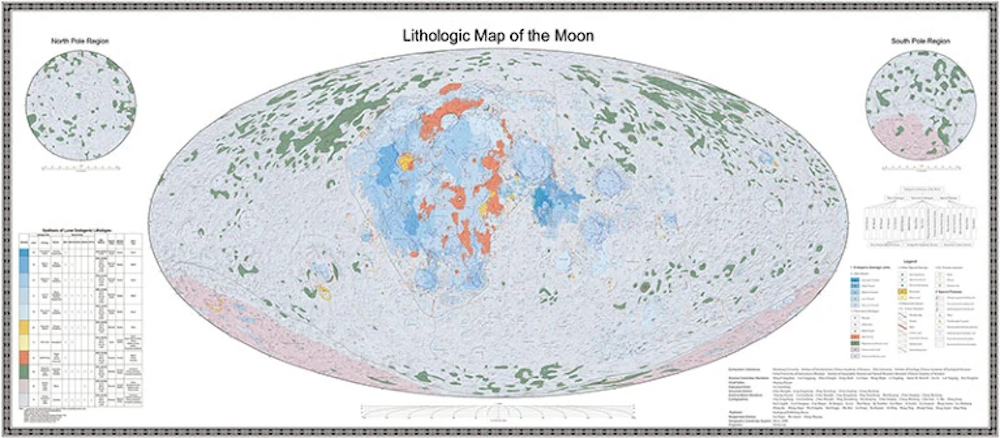If we want to establish a permanent human presence on the moon, we need more detailed maps than the existing options, some of which date back to the Apollo missions of 1960’s and 1970’s. After more than ten years of collaboration between more than 100 researchers working at the Chinese Academy of Sciences (CAS), the newest editions of lunar topography are rolling out for astronomers and space agencies around the world.
As highlighted recently by Nature, the Geologic Atlas of the Lunar Globe includes 12,341 craters, 81 basins, and 17 different rock types found across the moon’s surface, doubling previous map resolutions to a scale of 1:2,500,000.
[Related: Why do all these countries want to go to the moon right now?]
Although higher accuracy maps have been available for areas near Apollo mission landing sites, the US Geological Survey’s original lunar maps generally managed a 1:5,000,000 scale. Project co-lead and CAS geochemist Jianzhong Liu explained to Nature that “our knowledge of the Moon has advanced greatly, and those maps could no longer meet the needs for future lunar research and exploration.”
 Credit: Chinese Academy of Sciences via Xinhua/Alamy
Credit: Chinese Academy of Sciences via Xinhua/Alamy To guide lunar mapping into the 21st-century, CAS relied heavily on China’s ongoing lunar exploration programs, including the Chang’e-1 mission. Beginning in 2007, Chang’e-1’s high-powered cameras surveyed the moon’s surface from orbit for two years alongside an interference imaging spectrometer to identify various types of rock types. Additional data compiled by the Chang’e-3 (2013) and Chang’e-4 (2019) lunar landers subsequently helped hone those mapping endeavors. International projects like NASA’s Gravity Recovery and Interior Laboratory (GRAIL) and Lunar Reconnaissance Orbiter, as well as India’s Chandrayaan-1 probe all provided even more valuable topographical information.
The pivotal topographical milestone wasn’t an entirely altruistic undertaking, however. While CAS geophysicist Ross Mitchell described the maps as “a resource for the whole world,” he added that “contributing to lunar science is a profound way for China to assert its potential role as a scientific powerhouse in the decades to come.”
[Related: Japan and NASA plan a historic lunar RV road trip together.]
The US is also far from the only ones anxious to set up shop on the moon—both China and Russia hope to arrive there by the mid-2030’s with the construction of an International Lunar Research Station near the moon’s south pole. Despite the two nations’ prior promise to be “open to all interested countries and international partners,” the US is distinctly not among the 10 other governments currently attached to the project.
China plans to launch its Chang’e-6 robotic spacecraft later this week, which will travel to the far side of the moon as the first of three new missions. In an interview on Monday, NASA Administrator Bill Nelson voiced his concerns of a potential real estate war on the moon.
 Credit: Chinese Academy of Sciences via Xinhua/Alamy
Credit: Chinese Academy of Sciences via Xinhua/Alamy “I think it’s not beyond the pale that China would suddenly say, ‘We are here. You stay out,’” Nelson told Yahoo Finance. “That would be very unfortunate—to take what has gone on on planet Earth for years, grabbing territory, and saying it’s mine and people fighting over it.”
But if nothing else, at least the new maps will soon be available to virtually everyone. The Geologic Atlas is included in a new book from CAS, Map Quadrangles of the Geologic Atlas of the Moon, which also features an additional 30 sector diagrams offering even closer looks at individual lunar regions. The entire map resource will soon also become available to international researchers online through a cloud platform called Digital Moon.
















